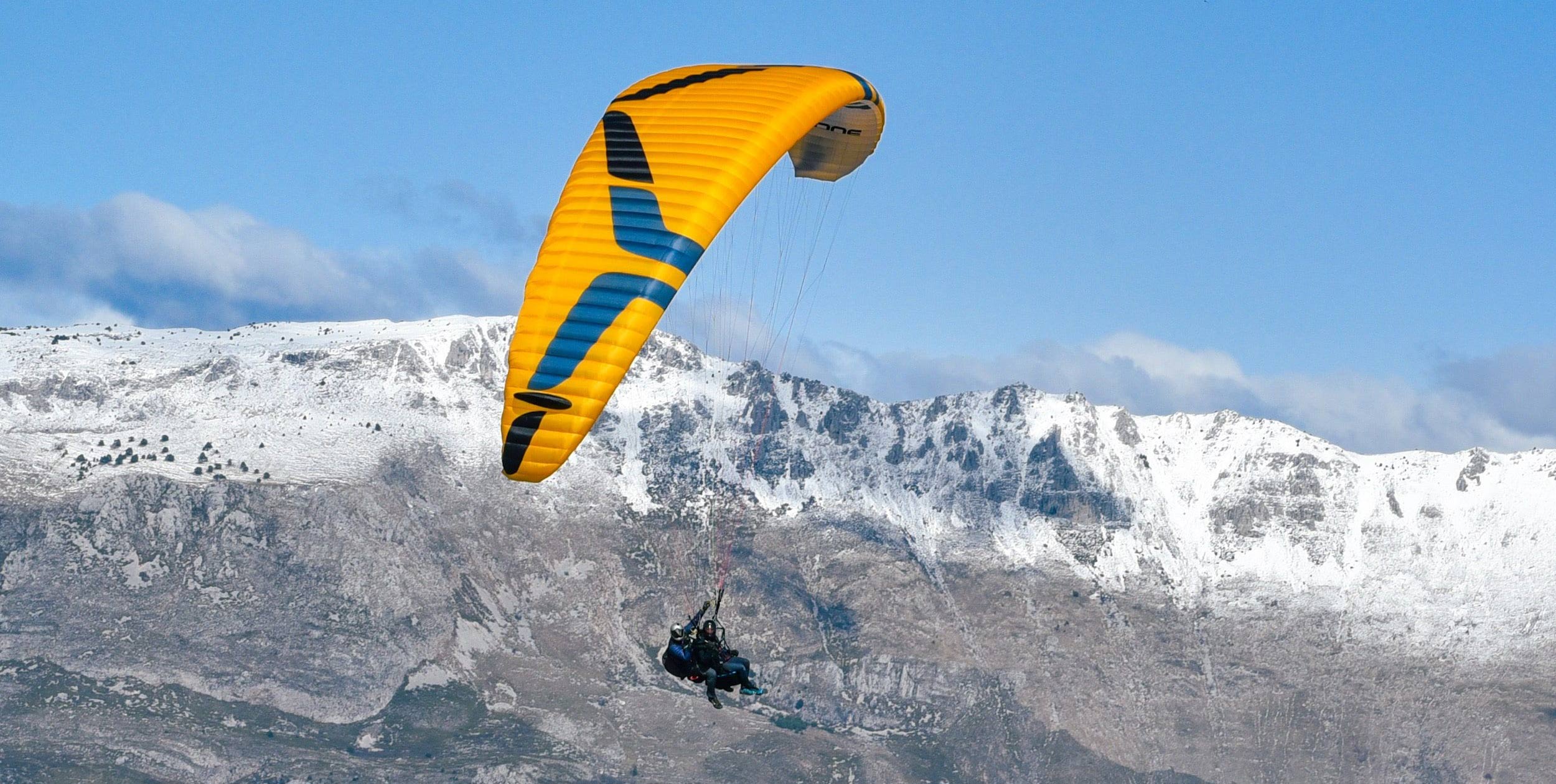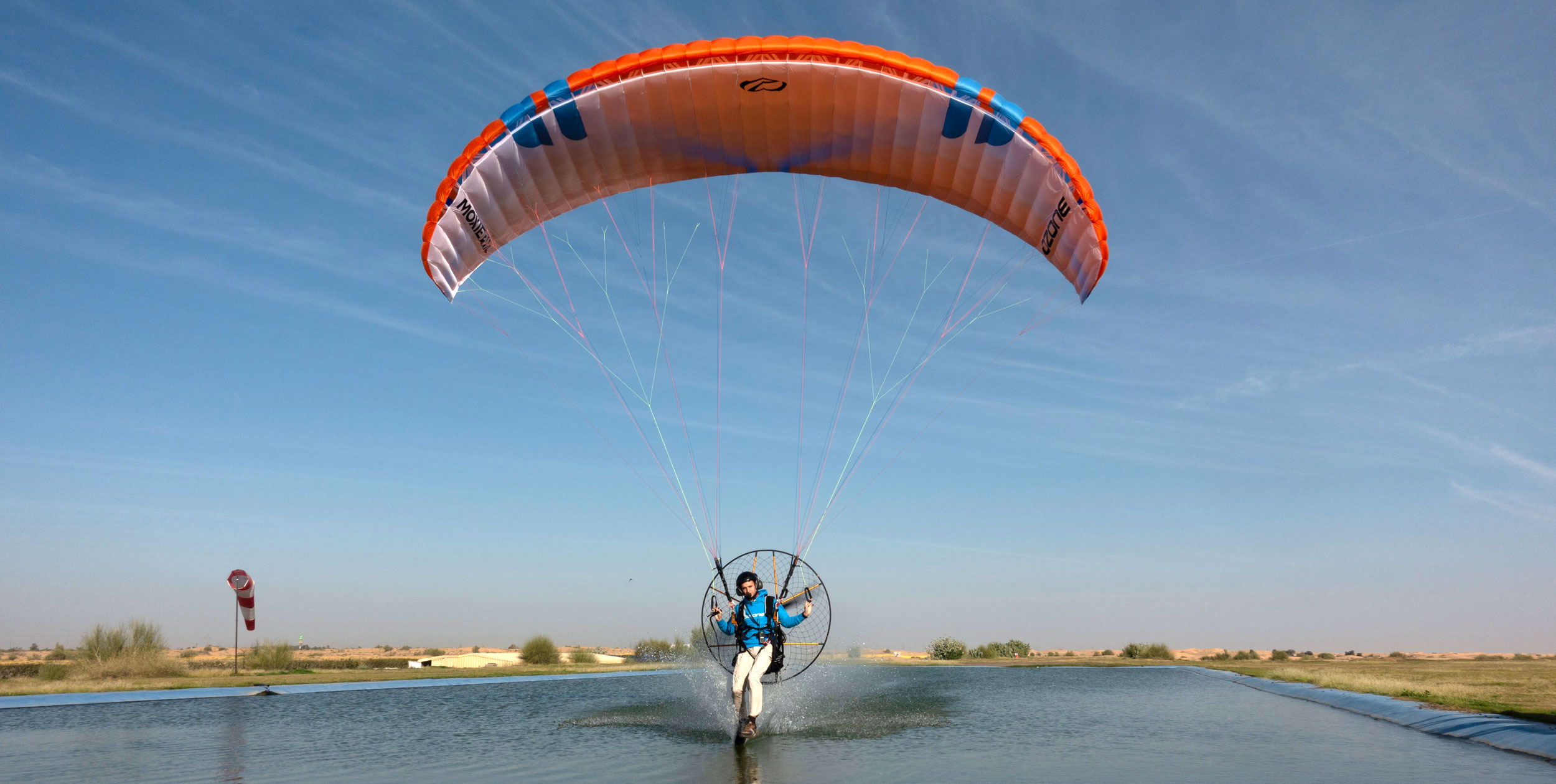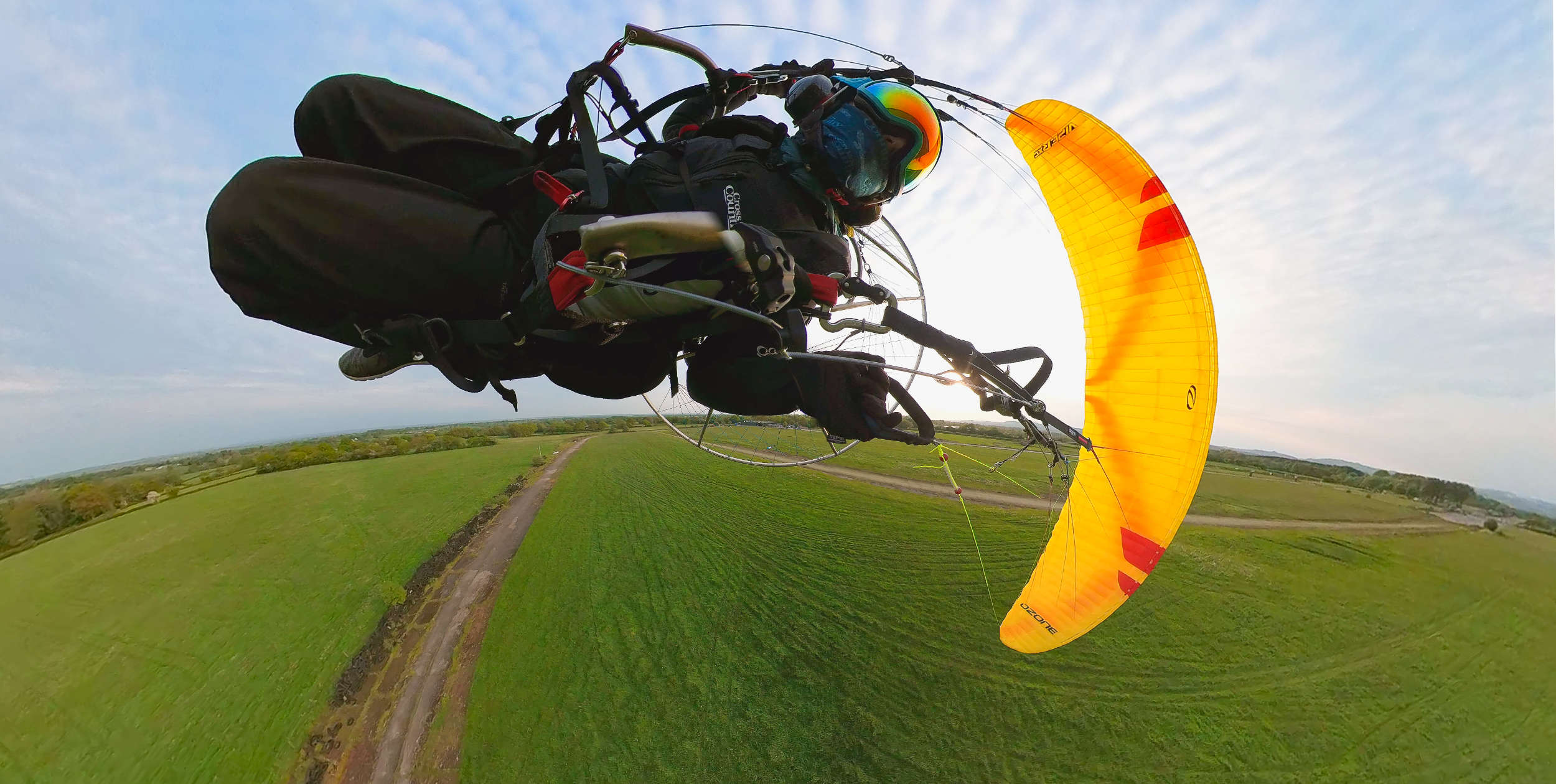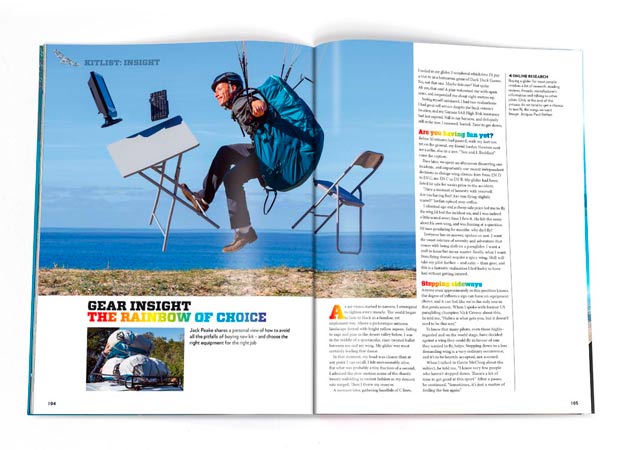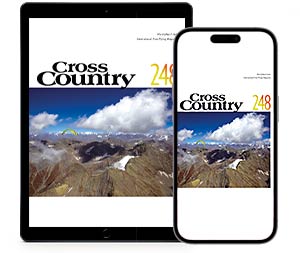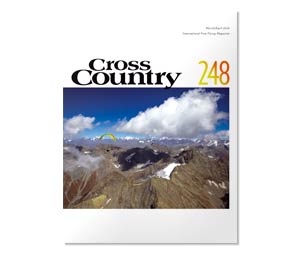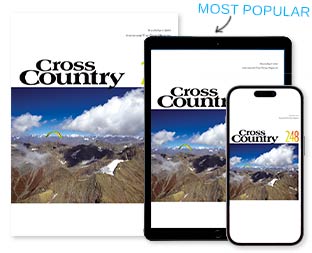As the world celebrates the 60th anniversary of the ascent of Mount Everest, Cross Country magazine editor Ed Ewing takes a look at the history of free flight on the highest mountain in the world.
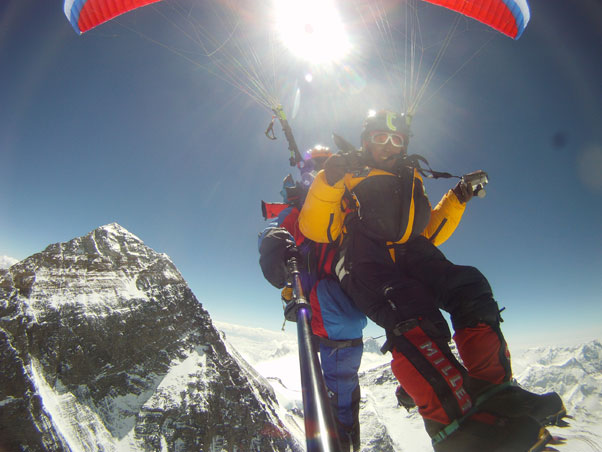
Babu Sunuwar and Lakpa Tsering Sherpa tandem paraglide from the summit of Mount Everest on 21 May 2011. Photo: Babu Sunuwar
In 40 years of free flight, only three teams have flown from the summit of Mount Everest. French alpinist and pilot Jean Marc Boivin was the first person to fly a paraglider from the top, but he wasn’t the first to try to free fly from the mountain, and he certainly wasn’t the last.
1986: Hang Gliding from the West Ridge
US pilots Steve McKinney and Larry Tudor took up the challenge in the autumn season of 1986 to become the first pilots to fly a hang glider “from Everest”.
Steve McKinney holds the honour of being first, but it was only a short flight from about 200m up the West Ridge, flown in marginal conditions in a bid to get some film footage to appease the sponsors of an expedition that hadn’t gone well from the start.
“The failure of our expedition came from logistics, not weather or the team,” Larry Tudor, the best pilot of the era, recalled later.
Attempting to climb the mountain from the north side meant travelling through China and Tibet. Chinese customs didn’t like the gliders and impounded them for days.
Eventually they got them out. Larry Tudor explained how Craig Colonica, “a six-foot three-inch 240 pound rock and ice climber from Tahoe, California” secured their release: “On the last possible day we went to the airport on a last ditch effort to get the gliders out. They were not going to let the gliders out and that was final.
“Craig went ballistic. His eyes turned blood red like a deer in your headlights. He grabbed the customs guy, yanked him over the counter and with his face inches away told the interpreter, ‘You tell this guy these are our gliders, we paid for them, we are here with permission from his government and if he doesn’t give us them to us right now I’m going to twist his head from his skinny little neck.’”
That worked.
“Instead of going to jail we had the gliders loaded on the truck in record time and caught the next flight to Chengdu.” In his report from the time, Larry warned, “Never push a Sicilian over the edge, it’s horrifying.”
A week later they were at base camp and set about establishing camps up the mountain. “The whole time the weather was ideal,” reported Larry, “Warm sunny days with one or two cumulus clouds over each of the big peaks, light winds.”
The gliders however were in transit and took a month to arrive.
When they did, the weather turned. “We missed our window,” wrote Larry.
“We had problems with jet stream winds that arrive with winter … The winds forced us off the mountain. I spent three days and four nights in a tent on the west ridge at 22,000ft waiting for the winds to back off. Bob Carter spent the next night before retreating. You haven’t lived till you have been in a nylon tent in 100mph (170km/h) winds.”
Larry added: “[Eventually] we got one of the gliders to the top of the West Ridge. But it was too late. The jet stream winds had descended on the mountains and the expedition was out of money and wondering how we were going to get out of the country.”
It was time to go home, but not before Steve McKinny’s flight from Everest. “It was from about 200m up the West Ridge so the film crew could have something to appease the sponsors,” explained Larry. “He also made a very spectacular out-of-control flight to a wicked crash on the glacial moraine at base camp.”
1988: Jean Marc Boivin paraglides from the summit
In 1979 Jean Marc Boivin, a talented, stylish alpinist and pilot with a great flair for promotion, had flown a hang glider from the south west ridge of K2. Aged 28 he had joined a high profile, traditional siege-style expedition packed full of some of the era’s most famous names in French climbing.
The four-month long expedition was the biggest and most expensive ever mounted in the history of K2. Some 1,400 porters carried 25 tonnes of equipment to base camp. There were 10 filmmakers, press photographers and journalists.
The expedition to climb ‘The Magic Line’ failed 160m from the summit. However, from Jean-Marc’s point of view the expedition became a success when on 6 September he rigged his hang glider and launched from Camp IV at 7,600m. His sled-ride lasted 13 minutes and took him back to base camp 2,600m below. In the process Jean-Marc set the world record for the highest ever hang glider take-off.
The flight won him acclaim around the world, and earned him the International Award for Valour in Sport, a prize given to him at an awards ceremony in London on 5 February 1980.
Six years later he was back in the high Himalaya. This time as a member of an expedition to another 8,000m peak, Gasherbrum II. He spent May to August on the mountain and summited along with other team members on 8 July.
A few days later he set off from base camp again and reached the top in 16 hours on the evening of 14 July 1985. It was a big difference to the siege style adopted on K2 and represented the evolution of Himalayan mountaineering away from long drawnout expeditions to the modern, move fast and travel light style that prevails today.
Jean-Marc then flew from the summit by hang glider, setting a new launch altitude record of 8,035 m. A film, L’Oiseau Rare, was made of this expedition. (If anyone out there has a copy, we would dearly love to see it.) A success, the expedition was however marred by tragedy when team member Toru Nakano slipped and fell to his death. A sad end to an expedition that marked a turning point in mountaineering style, and set a remarkable hang-gliding record that, to our knowledge, has never been bettered.
His flight however marked the end of climbing and exploring the high Himalaya by hang glider. Because while Jean Marc flew his hang glider from the summit on 14 July, he was pipped at the post.
Jean Marc was reportedly shocked when another French alpinist had flown from the summit a few days earlier using a very early paraglider. Pierre Gevaux was the first pilot to fly from the summit of an 8,000m peak by either hang glider or paraglider when he made the descent of Gasherbrum II on 11 July 1985.
Pierre Gevaux paraglides from Gasherbrum II in 1985
The new craft immediately caught Jean Marc’s interest – and his thoughts turned to the big one: Everest.
That moment came on 26 September 1988 when, after reaching the summit at 2.30pm with four other European climbers and two Sherpas, he spent 90 minutes preparing his wing. The wind was gusty, reported to be peaking at 40km/h, but he found a window and took off into Nepal.
The flight down to Camp II at 5,900m – nearly 3,000m below the summit – took 11 minutes. A plummet averaging 270m a minute, or a 4.5m/s sink rate (900ft per minute).
Another climber at base camp that year recalled Jean Marc:
“He was your basic French cool personified. Everything he had had the logo ‘Jean-Marc Boivin Extreme Dream Team’.”
By taking advantage of the birth of paragliding to fly off Everest Jean-Marc achieved his dream. By default, it was extreme.
A cine film of Jean Marc Boivin’s historic paraglider flight from the summit of Everest on 26 September 1988
The 1990s: Paragliding takes off
Paragliding had arrived. And alpinists and climbers took to the sport with zeal. It offered an easy way down – if conditions were right.
An early adopter was a 17-year-old Bertrand ‘Zebulon’ Roche who was a passenger on a tandem flight with his father from Everest’s 8,000m South Col in 1990. Remember his name, he comes back later.
In the decade after Jean Marc’s high profile flight, paragliding spread across the Himalaya, taking root in traveller hang-outs and accessible flyable spots across the region. Pilots arrived from Europe and started to explore. Vol bivouac, flying and camping through the mountains, offered adventurous pilots unlimited horizons.
It wasn’t all vol biv and lakeside chillout however. Climbers were still using paragliders to attempt to fly from the big peaks. And chief draw was Everest. In 1998 the veteran Russian climber Elvira Nasonova tried to launch a tandem from above the Khumbu icefall on the mountain while climbing Everest, but it didn’t go well.
Reports from the day read: “The start was unsuccessful. In the moment they took off from the rock a gust got up. The sportsmen were knocked against the rock, the glider soared upward and Elvira and her instructor fell down on the glacier from about 50m.”
The instructor escaped unscathed but Elvira was badly hurt and spent three days lying injured on the glacier. Eventually she was rescued by helicopter and she survived.
2001: Clare and Zeb: Tandem from Everest
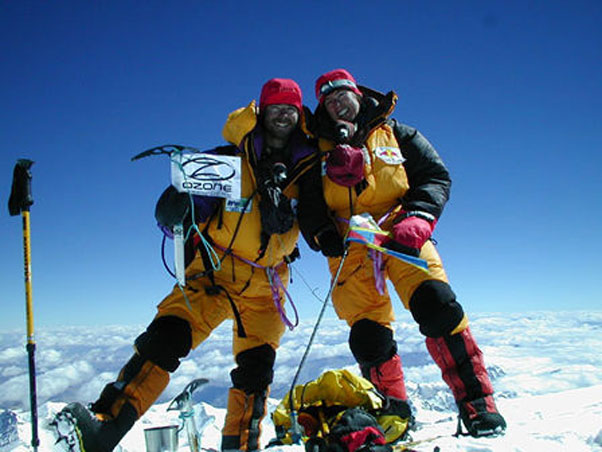
Zeb and Claire on the summit of Everest, before their tandem paraglide into Tibet. Photo: claire-zeb.pagesperso-orange.fr
By 2001 Everest had had a decade of commercial climbing expeditions. To climbers from a previous era the mountain had become tarnished. Ego and publicity had taken over the climbing game, said many. Modern life had reached the roof of the world.
Bertrand Zeb Roche straddled these two worlds. As a 17-year-old he had summited Everest then flown from the South Col with his father. Now he was back on a pilgrimage to the summit with his wife, Claire Bernier. Together they were climbing and flying the Seven Summits – the highest peak on each continent.
They reached the summit at 8am on 21 May 2001 carrying a specially made Ozone tandem paraglider that weighed only 5.3kg.
This was a precursor of what was to come. The lightweight revolution would take off from there, giving pilots sub-3 kg wings and 300g harnesses.
They were extraordinarily lucky with the weather. At the summit, Claire reported after the flight: “It was 8am. The view was breathtaking. Not a cloud, the wind was between 30 to 40km/h.”
After taking summit photos the pair found a spot 10m below the 8,848m top. Claire wrote: “We took off our oxygen masks and prepared the wing. These tasks, which were so easy below, were very trying up there. It took an hour to get ready.
“Then, sat one on top of the other, on the edge of the mountain, Zeb put the sail up and very quickly the wind took us to that mythical place. For a few minutes, we were birds.
“We got a brief glimpse of the West Face and then we headed off north, in the direction of the Chinese Base Camp. We saw the whole route up.
Paragliding is magical and effortless!
“The countryside flashed by. The conditions weren’t as calm as they seemed, the west wind changed our flight path. Above the North Col, the wing started to flap violently, reminding Zeb of competition flights. We were distancing ourselves from anything which could cause turbulence. At 10.22am we set down gently on the Rongbuk glacier, just above 6,400 metres.”
Stylish, and apparently effortless. Not so for the Dutch pair who tried to repeat the feat the next year in 2002. Again sponsored by Ozone Wilco van Rooijen had to report back that the wing had been carried to Camp III where they were then blasted by winds. The camp was “torn apart” and the glider “flew off on its own, still in its bag”.
A team press release later said: “We like to think this just goes to show you cannot keep a good glider down and that Ozone gliders can fly even in the bag, although we’re not sure about the glider’s performance.”
2004: Hang gliding over Everest
Hang gliders were back on Everest in 2004. This time being towed up by microlight.
Hang gliding legend Angelo D’Arrigo was towed high up the south face by microlight world champion Richard Meredith Hardy, getting well above 8,000m before the tow-rope snapped.
Angelo reported afterwards: “We were at a height of about 9,000 meters, I was 500m south of Everest. I released what was left of the towrope and headed for the peak, flying over it soon after.
This was the moment, flying over Everest. I had succeeded in the attempt to fly my hang glider over the highest mountain in the world.”
The flight was not without controversy, however. Some questioned whether Angelo had indeed flown right above the summit. A moot point for some – four hours in the air at up to 9,000m around Mount Everest is enough for many. But for others it was not enough. Angelo lacked a GPS tracklog, which left some purists asking exactly how far, how high. Climbers on the summit that day said they saw a microlight overhead, but no hang glider.
Cross Country magazine reported at the time that the tow-rope had broken at 8,700m, and that Angelo soared the West Face to the summit. They said he was “the first person to ever soar Everest’s summit”, but were shy of making an unambiguous call about exactly how high, and whether he went above the top or not. Sadly Angelo died two years later, leaving behind a question mark for some, while others said Angelo’s word is his word.
Either way, it was an incredible flight that pushed boundaries in every way.
The controversy though was echoed in 2007 when TV adventurer Bear Grylls made a powered paraglider flight in the region and initially claimed on his blog to have flown over Mount Everest. A lack of GPS data and film footage meant his claim was, at least in the sport’s circles, deemed not credible.
2011: Babu Sunuwar and Lakpa Tsering Sherpa
In 2011 several teams were on Everest hoping to fly from the summit. British woman Squash Falconer successfully summited but poor weather meant she didn’t fly off. A second climber, from Brazil, also carried hopes of paragliding off but didn’t.
The team that did however, caught the imagination of the world. Nepali nationals Babu Sunuwar and Lakpa Tshering Sherpa successfully climbed and flew from the summit by tandem paraglider on 21 May 2011. It was, to the day, 10 years after Zeb and Claire had flown tandem from the summit.
Babu, a tandem pilot in the tourist and trekking town of Pokhara, had caught the eye of the paragliding world the year before by completing a 30-day tandem vol-bivouac across Nepal in 2010. This sort of flying was considered hardcore and extreme, the preserve of elite pilots.
His flight from Everest thrust him into the public spotlight. His expedition was ‘From Summit to Sea’ and involved climbing Everest, flying tandem from the top, and then hiking and kayaking to the sea at the Bay of Bengal. For this adventure the pair were voted National Geographic Adventurers of the Year.
The flight from Everest was notable for another reason: the pair took off on the north side of Everest, rose in a thermal above the summit, and turned and flew into Nepal. They then carried on for 35km and landed at Namche Bazaar, the Sherpa capital.
The difference between Jean Marc Boivin’s first flight, when the basic technology saw him fly a fast controlled descent down the mountain and Babu’s flight couldn’t be starker. Moreover, the fact that it was two Nepali nationals marked a considerable shift. No longer the preserve of the European pilot exploring remote and adventurous places, this was an example of a local pilot flying in his own backyard. And in doing so pushing away old boundaries with one giant sweep.
Everest will see more climbers and pilots on its flanks in the decades to come. Smaller wings and advanced materials make gliders smaller and lighter every year – the lightest now weighs 1.5kg. But launching and flying from the highest mountain world will always remain a challenge. Three successful flights from the summit over the last 40 years of free flight history show us that, if nothing else.
More info
Babu Sunuwar flies from Everest
An interview with Claire and Zeb
DVD: Flying over Everest with Angelo D’Arrigo
DVD: Hanuman Airlines, Paragliding from the summit of Mount Everest


